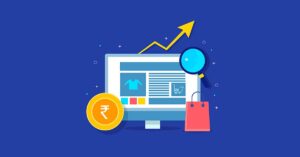If we were to play buzzword bingo with retail tech jargon for 2023, headless commerce would be a prominent square. It’s a topic that’s becoming more popular as more retailers are considering upgrading their eCommerce infrastructure from monolithic legacy platforms to a more flexible and modular solution to enable a better customer experience management strategy for audiences across channels.
In this blog, let’s take a look at how headless commerce and other prominent approaches and technologies are transforming the eCommerce landscape — something that eCommerce leaders must keep a close eye on.
1. Headless Commerce
Headless commerce refers to the approach of disconnecting the front-end and back-end of eCommerce systems in order to enable innovation and customizability. There are no explicit dependencies between these two layers, which communicate via API.
Headless commerce architecture enables the creation of streamlined systems by assembling loosely coupled parts, much like digital LEGOs. With headless commerce platforms, merchants can freely construct their headless stack by adding, deleting, and modifying specific services to create a best-of-breed stack tailored to their needs. So, it isn’t surprising that the headless eCommerce CMS software market is expected to grow at a healthy CAGR of 22.1% up until 2032.
2. Composable Commerce
Composable commerce is a development strategy that involves picking best-of-breed commerce components and merging or ‘composing’ them into a unique application designed to meet specific company goals. It paves the way for bringing ML, AI, and big data to the mix.
Traditional commerce platforms bundled tightly connected features and services as an all-in-one package. This served to hinder integrations across systems. Composable commerce alleviates this challenge.
3. Microservices
Microservices are currently used by 85% of commercial firms worldwide, with adoption rates of 75-84% among mid-sized businesses. That’s significant but understandable considering the requirement of scalability, agility, and reduced downtime (among other things) that this architecture suffices. Essentially, microservices alleviate the challenges posed by large, monolithic eCommerce systems that aren’t agile and accommodating.
A microservices-based eCommerce strategy allows businesses to integrate all the moving pieces of their eCommerce ecosystem across online and offline channels, enabling them to provide a unified customer shopping experience. All of this transpires while each service (for example, shopping cart, product listing, payment processing, inventory management) remains independent of each other. This way, issues at a certain place don’t necessarily spread throughout the system.
This is significant since consumers now increasingly prefer hybrid buying methods such as click-and-collect and buy-online-pickup-in-store. The eCommerce infrastructure needs to ensure near-100% uptime. Plus, additional features and functionalities may be added as needed, something that microservices facilitate — thus, “future-proofing” the commerce platform.
4. Augmented Reality (AR)
Research outlines that AR-powered products are 200% more captivating than those that do not employ AR. This rings true for the eCommerce domain as well.
AR enables users to view how a product would look like in the real space. This could be a cloth that they’d preferably want to virtually try on or a piece of furniture that needs to be assessed for its aesthetics and dimensions while it’s placed in the living room.
Of course, this significantly amps up the ability to make a purchasing decision via online shopping. Industries such as fashion and home design are particularly viable for disruption using this technology because the user can obtain a better sense of the item without seeing it in person.
5. Containerization (and Cloud-Native)
Lower operational expenses, better eCommerce security, easier maintenance, and, most importantly, considerably more market agility — the benefits of containerization are many.
In essence, container technology enables enterprises to deliver applications or services in a modular fashion. Because each service is housed within its own virtual runtime environment, it may be upgraded or withdrawn without having an impact on the rest of the digital chain. Similarly, new features can be seamlessly introduced.
Most eCommerce operations are composed of tens, hundreds, or even thousands of containers, all of which will work in tandem owing to the clever use of APIs. These containers are also easily reproduced, making the technology extremely scalable and ready for automation, especially when combined with an orchestration platform like Kubernetes or Docker.
Containers help enterprises build cloud-native applications. Of course, just being “in the cloud” is no longer sufficient. eCommerce businesses must be able to make the most of the cloud resources, while ensuring that sensitive and confidential user information is protected.
6. Blockchain
As per Research and Markets, the blockchain technology market will reach $39.7 billion by 2025 at a whopping CAGR of 67.3%. The research firm predicts that the eCommerce segment will see the highest growth across blockchain technologies.
Blockchain has enormous promise for revolutionizing several parts of eCommerce, such as supply chain management, payment processing, and consumer data protection. eCommerce executives may improve transparency, traceability, and trust throughout the supply chain by deploying blockchain technology, eliminating counterfeit products and increasing customer confidence.
Furthermore, blockchain-based payment systems can support safe and decentralized transactions, removing the need for middlemen and lowering overall transaction costs.
Conclusion
eCommerce leaders must embrace technical advancements that enable them to create excellent user experiences and streamline commerce operations in an otherwise immensely competitive eCommerce landscape.
Now, of course, with a broader range of possibilities, not every trend would suit your business requirements. While some will accrue significant value, others may not suffice well for your target demographic or be too sophisticated to deploy or maintain.
But how do you identify or niche down on those that do? And what if they entail significant technical effort on your part but are immensely valuable for realizing an excellent ROI? That’s where an expert eCommerce technology partner like Ignitiv can help. Get in touch with us with your requirements, and let us strategize for a more robust eCommerce infrastructure for your business.








